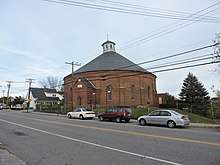Gasholder house
A gasholder house is a structure built to surround an iron gasholder in which gas is stored until it is needed. Before the 1870s, most iron gasholders were constructed without a building structure, but following practices already common in the New England, gasholders houses were adopted in New York. Additionally, gasholder houses were constructed in England as early as 1825, although the mild climate made them less of an advantage.
Gasholder houses were built to protect the iron gas holder from the elements, and enabled it to be built from thinner plates. A gasholder house provided a number of advantages:
- Provides a way to withstand the wind, and the forces on the thinner iron gasholder.
- Avoids snow loads on the top of the holder, and icing of the guides that controlled the vertical movement of the gasholder.
- Prevented the freezing of water in the pit around the gasholder that provides the seal to the gasholder, thus preventing the loss of gas.
- There is also some belief that a gasholder house allayed fears about explosion from the stored gas.
The gasholder house also provides economic advantage by reducing the condensation of gas in cold weather, and provided an attractive architectural element of the gas complex.
There are eleven known gasholder houses in the United States, with the structure in Troy, New York being one of the largest remaining structures of this type.[1]

List of gasholder houses
- Erdberg, Austria[2]
- Gasholder House (Concord, New Hampshire)[3]
- The gasholder house in Troy, New York bears a plaque from 1873, and the structure appears on an insurance map from 1875.[1]
- Gasholder House (Oberlin, Ohio)[4]
See also
- Gasometer, Vienna
- Østre Gasværk Teater, a theatre housed in the former masonry shell of a gasholder
Notes
- "Historic American Engineering Record, Troy Gas Light Company, Gasholder House". Retrieved 2010-09-18.
- "New Gasholder At Erdberg". Retrieved January 5, 2013.
- "Concord Gas Light Company, Gasholder House, South Main Street, Concord, Merrimack County, NH". Library of Congress. Retrieved January 5, 2013.
- "Oberlin Gas Lighting Company Gasholder House". Retrieved January 5, 2013.